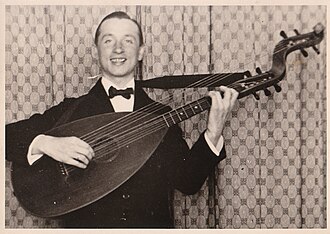German bass lute

The German bass lute or theorbed guitar lute is a special type of guitar lute or "German lute". Its neck is extended beyond the pegbox and has a second, laterally offset pegbox with a larger length . It is also called the gooseneck because of its curved connection . Depending on the version, this takes up 2 to 9 free-swinging bass strings ( drone strings ), which are also called contrasings . The result is an 8 to 15-string instrument in a double-guitar tuning . H. the playing strings are like the guitar and the bass strings are tuned diatonic downwards . In order to avoid bass strings that are too low and no longer sound good, the lowest playing string is sometimes also tuned from E to G and the bass strings then go to F instead of D to F. Examples:
- ten-string bass lute (with four bass strings), A -, B - C - D | E - A - d - g - h - e '
- twelve-string bass lute (with six counter strings), A -, B - C - D - E - F | G - A - d - g - h - e '.
construction
The German bass lute has essentially three forms:
- Round belly: The construction parameters are basically the same as those of the guitar lute. In most cases, the body is somewhat more voluminous with the same playing string length (620 to 630 mm). The body transition is at fret 7 to 9. Only maple is used as the body wood, the top is mostly made of spruce. Up to four drone strings are carried by a floating pegbox, from six drone strings the upper pegbox is supported on the edge of the body with a metal rod.
- Half-round belly: The more stable frame design is primarily used for bass lutes with 12 or more strings. The body transition is at fret 9 to 10. Here, too, a metal support rod for the bass pegbox is standard.
- Scholander lute (false Swedish bass lute): The Swedish musician Sven Scholander made this somewhat strange looking instrument famous at the beginning of the 20th century. The frame lute is based on the construction parameters of the Swedish lute from the 18th century. At first glance, it looks bulky and crooked. For the playability of the higher registers, however, their "kinked" body is a great advantage (playable up to around fret 14).
- Other designs: There are a few round bellies with a back plate. These instruments act as if the shell had been "sawn off" and closed again with a base plate. It is not known whether this type of instrument was ever built in this way, or whether this body shape was the result of repairs.
As a rule, the drone strings of German bass lutes have the same length of 840 to 880 mm, rarely up to 930 mm. Rising bass gauges are often achieved by sloping or curved metal wire bridges. Ascending single saddles, as they are known from the Viennese Schrammel guitar , are very rare in bass lutes.
history
One of the original reasons to theorize a guitar lute may have been the orientation towards the lute instruments of the Baroque period , when attempts were made to do justice to musical orientations ( figured bass ) by expanding the bass register and so alongside the actual baroque lute instruments such as the theorbo, angelica , Arciliuto and Chitarrone created.
Because the drone strings also act as resonance strings, the German bass lute has a sound volume that is far superior to that of a conventional guitar lute. Their volume and richness of sound make them suitable for "unplugged" performances in front of a larger audience. You can sometimes see these instruments in old photographs of recitals for soldiers from the time of the First World War .
From 1921 onwards, Johann Sebastian Bach's “ lute music ” , arranged by Hans Dagobert Bruger, was performed on the German bass lute with four contras.
Due to the further development of the powerful guitar and the triumphant advance of electrical signal amplification, bass lutes slowly died out from the 1930s. Today it is rarely made as a one-off piece by experienced lute makers on customer request.
Web links
Individual evidence
- ^ Hans Dagobert Bruger: Johann Sebastian Bach, compositions for the lute. First complete and critically reviewed edition. Transcribed and edited from old source material for today's lute. 1921; 3. Edition. Julius Zwißlers Verlag (owner Georg Kallmeyer) 1925; Reprinted by Möseler Verlag, Wolfenbüttel / Zurich.
- ↑ Wolf Moser : The repertoire second hand. The history of the transmission and its tasks. In: Guitar & Laute Volume 9, 1987, No. 3, pp. 19–26, here: pp. 25 f.

